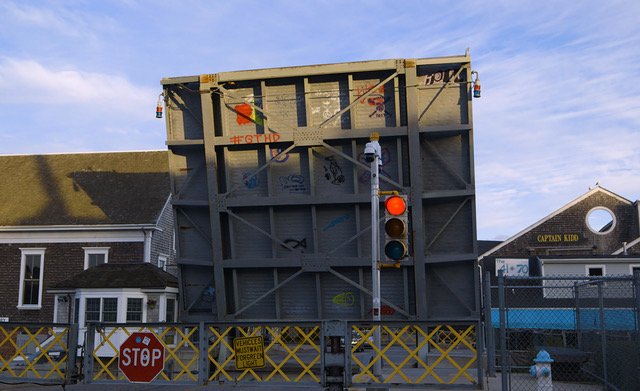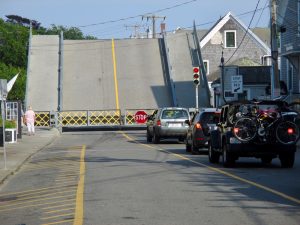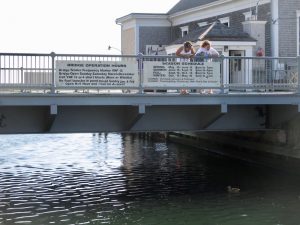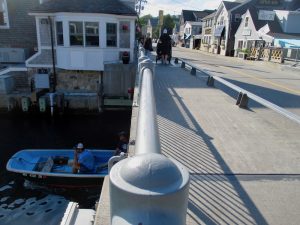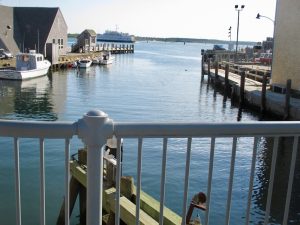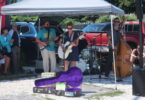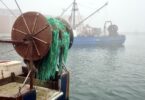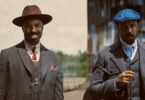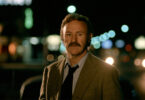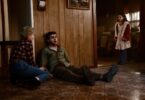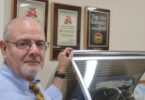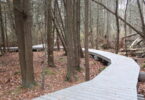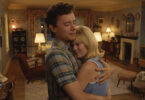WOODS HOLE – In the height of the Cape Cod’s summer bustle, the drawbridge over Eel Pond in Woods Hole makes everybody wait.
The bridge is raised for boats to enter or leave Eel Pond. Waiting for the bridge to slowly raise and then slowly lower, causes seemingly all the activity swirling around the busy village to pause.
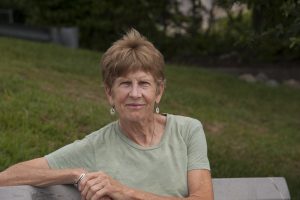
Filmmaker Marnie Crawford Samuelson has made a new film about the Woods Hole Drawbridge.
PHOTO BY ROWENA OTREMBA
Marnie Crawford Samuelson, a Cape Cod filmmaker and photographer, noticed this phenomenon when she was at the Woods Hole Film Festival last summer with a film she made about ticks. Fascinated by what she saw, she decided to make a film about the bridge.
“This is really a zen bridge. When the bridge goes up, time stops and everyone needs to stop. That’s kind of curious,” she said.
She and Shane Hofeldt co-directed the film which has been playing at film festivals, including the Provincetown International Film Festival last month and the Woods Hole Film Festival this month.
“Keeper” is being shown as the first film on the opening day of the Woods Hole Film Festival on Saturday, July 28, at 2pm. The film plays, appropriately, with a full-length feature, “Keepers of the Light,” about the Gay Head Lighthouse on Martha’s Vineyard.
“This is really a zen bridge. When the bridge goes up, time stops and everyone needs to stop.” – Filmmaker Marnie Crawford Samuelson
They hit upon the name “Keeper” for the film late in the process of the project, Crawford Samuelson said. “I said to Shane, ‘It’s like a village keeper.’ Shane said, ‘How about just ‘Keeper’?’ The reason it resonates for me, it gets at the notion of time, which is what the film is about.”
Taking the viewer through the times of the year and the times of day, the film strikes an elegiac tone as it captures the bridge going up and down.
Crawford Samuelson said, “The bridge is like a metronome. It’s keeping time. Every half hour or hour when there’s a boat in season. There’s sort of a regularity about it. And I feel like the bridge has got a protective quality for the village. It’s the connector between the bridge and Eel Pond. Eel Pond is a refuge for the village. If a storm is kicking up, you need to get home.”
Getting home may require a boat to go under the bridge into Eel Pond or a person to cross over the bridge to get to their home, making the bridge a kind of conduit to safety, she said.
But Crawford Samuelson said she leaves it up to the viewer to make their own connection. “The title is open. It’s not for me to interpret. It’s for people watching the film to interpret,” she said.
Though she grew up outside of Boston, Crawford Samuelson’s Cape Cod connection goes way back to summer camp in Chatham which she attended beginning at age 13. She returned to the Cape as an older teen, teaching sailing in Orleans.
“I was an obsessive sailor,” she said.
More than three decades ago, she moved to the Cape to work as a journalist for the Register and then for the Cape Cod Times, serving at one point as the Provincetown bureau chief. She found her passion was really in photography rather than writing. She quit her job and became a freelance photographer, working for national magazines among other publications.
Now 71, she has lived part-time in Boston and part-time in Wellfleet for many years. About 15 years ago, Crawford Samuelson said, the industry was changing and there were fewer jobs for photographers. Many photographers that she knew started moving into documentary video. It was a movement, she said, driven by newspapers wanting photographers to come back from assignments with video in addition to still photos.
“I followed that wave. I started learning this medium. It’s harder than you might think to make the transition. I got really interested in narrative and voice and all that goes into making films,” she said.
Crawford Samuelson credits her collaborator, Shane Hofeldt, with playing a gigantic role in all of their projects, though he typically makes his contributions from his home in Maine. He serves as co-director, remotely, as she sends him footage and works out the story with him from the beginning. He has the critical role as the film’s editor as well.
Also a major contributor to “Keeper” is the music, an original score by Kyle Oppenheimer of New York. “Especially in a film like this, music plays a big, creative part,” she said.
“Keeper” is Crawford Samuelson’s ninth film. All but one of the others also involve Cape Cod subject matter, including artists, oyster farmers and her film about ticks.
“There’s a kind of impermanence. It’s pretty Buddhist I would say, and mindful. What does it mean to pause? What does it mean to wait?” – Marnie Crawford Samuelson
But it may have been Crawford Samuelson’s previous project, the one not about Cape Cod, that propelled her to do a film about the zen-like bridge in Woods Hole. That film, “Fire Station 88.1,” was about the wildfires in California. “The heart of the film was about trauma to a community. This film was like the opposite,” she said about “Keeper.”
Crawford Samuelson said her films all have something in common.
“I think all the films we’ve done are about place. It’s about a bridge but it’s really about a village and a moment in time kind of seen through a bridge,” she said.
“Keeper” is a contemplative film that carries its meditative mood as a signature quality. Crawford Samuelson said that is deliberate. “That really influences the shooting style,” she said. She shot the entire film from a tripod.
“Everything is from a still position, waiting and anticipating for whatever action comes into the field and disappears. There’s an impermanence. It’s pretty Buddhist I would say, and mindful. What does it mean to pause? What does it mean to wait?”
Crawford Samuelson herself learned what it means to wait while making the film. She would set up her tripod and wait for, perhaps, a certain shadow that she knew the bridge would make if it rose at around 8:30am. But if it did not raise at that time, she would need to be back the next day to wait for the bridge to cast that certain shadow that she wanted to capture. “You can be waiting for hours,” she said. She recalled, people would pass by and say, “You’re still here?”
The film features several voices of locals. With the help of Woods Hole Library Director Margaret McCormick and other Woods Hole friends and locals, Crawford Samuelson tracked down “interesting people who would have something to say about their relationship to the bridge.”
While she interviewed many people, she ended up using just seven voices in the film: Charro Zuck, Amy Wilson, Crickett Warner, Mike Botelho, Buddy Ferreira, Denise Backus and Jim Brown
“We wanted to make a somewhat experimental film and it would be primarily visual and instead of packing it with voices, we decided to just make the audio as scant as we could make it, so it would just float along with what you’re seeing,” she said.
She said she is grateful for all the support from everyone she talked to, especially the bridge tenders. “They were incredibly generous with me. If they had shut me out from being inside the [bridge tender’s] hut, it would have made a big difference.” She added, “They have such a presence there. They are keepers.They have their eye on the boats and the pedestrians.”
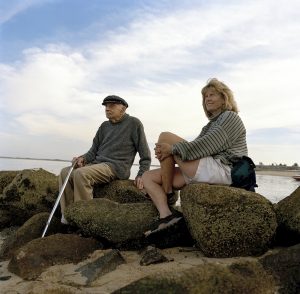
Filmmaker Marnie Crawford Samuelson with poet Stanley Kunitz in Provincetown. Crawford Samuelson has made the new film “Keeper” about the Woods Hole Drawbridge.
PHOTO BY GENINE LENTINE
As to what surprised her in making the film, she said it reminded her of how she felt when she was working on a book with the poets Stanley Kunitz and Genine Lentine, a story about aging, creativity and Kunitz’s time in his Provincetown garden. “Every time I went into his garden, there was always something different and the bridge is the same way.”
There were other surprises, such as the stencil drawings of cormorants painted on the base of the bridge. “Those are pretty fantastic,” she said.
She also remembers noticing multiple sets of legs, which is all you see of pedestrians waiting on the other side when the bridge goes up “I was thinking, ‘This is hilarious. I wonder if everyone notices that,’” she said.
Another surprise: a conversation that happened while Crawford Samuelson was filming at the bridge. “I was standing on the bridge one morning. A guy walked across pulling a small bag. He said a friendly hello and then remarked he was shipping out that morning on the Atlantis. He was the captain, following in the footsteps of his father. This captain was heading for Uruguay. It was his last trip. He expected to be gone several months, returning at Christmas. From this little village, people voyage around the globe. That’s amazing.”
In one part of the film, Charro Zuck and Amy Wilson give some insider insight into the creative graffiti underneath the bridge and how it is made.
Zuck, who, Crawford Samuelson said, is, “an artist and a cook” says in the film that he grew up on a pirate ship, He also explains that the graffiti artist has to take into account that the drawings, which can only be seen when the bridge rises, will be seen from a far distance, many yards from the viewer. That becomes part of the planning. Wilson notes that a calm night is needed to make the drawings because the underside of the bridge can only be reached by boat.
Crawford Samuelson said of the graffiti artists, “It’s kind of a mystery. It gets passed down generationally to teenagers local to Woods Hole but no one’s going to tell. Clearly, it’s a Woods Hole thing.”
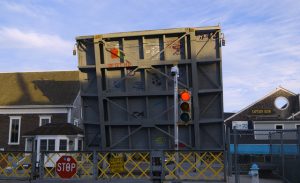
A view of the graffiti under the bridge from the short film “Keeper” made by Cape-based filmmaker Marnie Crawford Samuelson.
PHOTO BY MARNIE CRAWFORD SAMUELSON
Part of watching life around the bridge for the filmmaker meant watching the migrations as the seasons change. One particular migration that fascinated her was the migration of the houseboats, which are in Eel Pond in the winter and migrate into Great Harbor in the summer, then back to Eel Pond in the fall.
“It’s as important as the migration of the cormorants and the striped bass. It’s all an ecosystem,” she said.
The bridge was replaced some 15 years ago because it had become unreliable and unsafe, Crawford Samuelson said. But instead of upgrading the gates to a modern push button system, villagers concerned about maintaining community character insisted on keeping the old fashioned gates that have to be opened and closed by the bridge tender, who must leave his hut and latch and unlatch the device by hand.
“It’s so ritualistic.To me, it’s like watching the changing of the guard at Buckingham Palace.There was something poetic about it. Woods Hole would be a different place without that. It’s not the most efficient thing to do, but it’s really lovely. I’d call that a treasure, a gifted decision,” she said.
Crawford Samuelson also noted that there have been several other bridges in this same spot over the years. The first bridge was made of wood and later that was replaced by a stone bridge. “You just realize it’s part of a lineage of bridges and this won’t be the last,” she said. “It’s a bridge for this period of time.”
– Please like us on Facebook.

